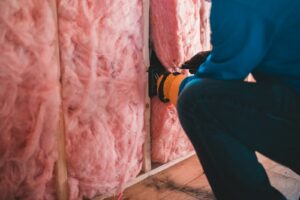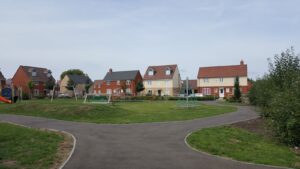When ‘building back better’ means safer and more inclusive places
St Helens Borough Council have begun a once-in-a-lifetime regeneration project with the English Cities Fund. Lisa Harris, the council’s Director of Place Services, explains what makes this project different and why other councils should follow suit.

The mission to revitalise any town centre so that it feels welcoming and inclusive, somewhere where people want to be, must always start with listening and engagement. We are all different and there is no-one sized fits all approach to regeneration. What may feel safe to a fifty-something man designing a series of new buildings and public places may seem much less inviting and secure to a younger or older person who walks by it on the way home.
This process goes beyond physical factors such as excluding dark corners and set-back spaces where somebody could step out in front of you. It starts and ends with understanding and addressing the experiences of diverse communities.
St Helens Borough Council is currently at the outset of a once-in-a-generation regeneration project with the English Cities Fund to restore the two town centres in our borough to their former glory – St Helens itself and neighbouring Earlestown. The principle of creating safe, inclusive spaces has driven our thinking and decision making from the earliest days.
One of the fundamentals was to make sure we are asking the right questions at the outset – because perceptions vary and how people use the space will be different. We also looked for a breadth of views and sought out unheard voices.
Over the past two years there have been two large scale engagement and consultation programmes where we presented ideas and asked for feedback, along with a series of pop-up events around the borough, a website where people could see the proposals and provide feedback, local media engagement and business briefings. This process also included going directly into schools and asking children of Generation Alpha, born after 2010, what they want from the town centre as, in many respects, we are investing, designing, and building in their name. The children’s requests included more green spaces, somewhere for flexible outdoor events, and better access to trains and buses. Making public areas feel safer was also singled out as a priority.
Everybody wants ‘family-friendly’ town centres – clean, attractive places where there are good things going on – but that should not be considered a bland tick-box slogan. In truth, it means considering all members of the family, and addressing the reality that families are made up of mix of ages and genders, people who are physically, emotionally, spiritually, and neurologically different.
Feeling safe is a huge issue for women of any age in their day-to-day life. A national YouGov survey in 2022 found that women are most likely to say they feel unsafe walking alone home at night, including a quarter (26%) who say they ‘always’ feel unsafe doing so. Half of women (53%) regularly avoid being out at certain times to reduce the risk of encountering harassment or sexual assault.
The evidence suggests that urban design has too often overlooked the needs of women and girls and actually limited their movement – if they go out, they choose longer routes, avoiding certain areas due to feelings of unsafety and insecurity. As a collective, investors, developers, architects, designer, planners, and the civic leaders should not accept this status quo and we share a duty to learn from the shortcomings of the past.
A lot of work has already taken place in St Helens. In collaboration with the Police and Crime Commissioner for Merseyside, we secured backing from the Government’s Safer Streets Fund to fund a series of projects designed to make women safer in the night-time economy.
Extra investment into CCTV is one practical and immediate response to the challenge and, from a policing perspective, there are also Secured By Design principles which provide guidance on reducing crime and anti-social behaviour. These tools have real value and make a positive difference but there is also an obvious need to consider safety and inclusively more broadly.
Our starting point, like every other borough, is working every day to address societal challenges that cannot be fixed through design alone. Again, this begins with data and monitoring how safe residents feel across the borough as a whole. Our most recent survey, from December 2023 showed that 86% of residents said they felt safe in daylight hours in their local area; it dropped to 50% in the hours of darkness.
In terms of practical measures in the town centre, we have a series of measures focused on improving every aspect of the night time experience. We have a Night Time Economy Forum chaired by St Helens councillor Kate Groucutt. It brings together businesses to work collaboratively with police and council. We also work directly with night time economy businesses and have put in place taxi marshalls, improved lighting at taxi ranks, more joint enforcement and increased communications and marketing in the town centre. While there is always more to do, we have enjoyed some successes. Our nighttime campaign has produced a reduction in crime figures. Our borough has also been recognised by the Purple Flag Charter, which is similar to Green Flag for parks and focuses on raising standards and broadening the appeal of town and city centres between the hours of 5pm and 5am.
As a guiding principle, prevention is always better than cure and town centre renewal means thoughtfully considered environments and civic pride as much as we sometimes must have cameras, walls, lighting and fenced off areas.
On the fundamentals, the approach to lighting is improving. Lighting is one of the physical tools that can attract more people to a space, creating an increased feeling of safety through presence and activity. Today, designers know to produce lighting solutions that avoid bright floodlights that create pockets of darkness, glare, or shadows. Instead, they can opt for multi-layered lighting, with a combination of uplighting, wall mounted lighting and street lighting.
It follows that visibility in the wider sense of day and night can help reduce the risk of anti-social behaviour by ensuring clear sightlines, avoiding blind spots, and incorporating open spaces.
This works because, thankfully, there is still a strong feeling that, in a civil society, people can and will protect each other. People make places and when more of us are present, spaces become more liveable and are less likely to be perceived as unsafe. Being seen is key in every sense and links to another guiding principle of safer and inclusive towns: the importance of well-activated spaces. They need to remain busy and lively during evenings and weekends. This can be through art, music, food or providing meeting places.
Active spaces create a sense of shared ownership and responsibility among community members. Delivering that level of engagement from local people and visitors is about ensuring there are a mix of uses in town centres and adapting to the changes to shopping and working habits that, over the last two decades, have radically changed the High Street. Gone are the days when High Streets could be considered in limited functional terms: you go there to shop. Successful urban centre regeneration today calls for a much wider breadth of activity.
In St Helens we have opted for a blend of core elements – a new 25,000 sq ft Market Hall as the centrepiece of a transformational mixed-use area that includes a 120-bedroom globally branded hotel, 75,000 sq ft of office space, 64 new homes and 11,000 sq. ft. modern retail space in the initial phase. The new Market Hall will be a daytime and evening destination, with space for arts events and entertainment, and places to eat and drink. We will also be creating a new arrival experience in the town, based around a new bus station, green spaces, and clearer routes to help people get around town centre. The different elements can work together to create an atmosphere that people want to spend time in.
Civic pride is also very much part of the equation. For us, that meant avoiding the curse of Anytown UK. St Helens is very much an area with a distinct identity and the borough has a sense of itself as both a place of market towns, rural villages but also industrial innovation, with a long history as a pioneering centre of Railways, Coal mining and glassmaking, a tradition that continues to this day. It follows that the design of the new buildings and places needs to capture and not ignore this heritage.
As a result, each of the new buildings in our town centre transformation plans has drawn inspiration from St Helens’ past, with architectural glass, a key feature within the Market Hall. The designs for the facades of the new buildings reference the local architectural traditions in other ways, drawing inspiration from detail in existing heritage buildings.
The work to deliver all these changes is about to start, with the deconstruction of the parts of the town centre that are no longer fit for purpose this summer. The end game truly is about ‘building back better,’ the phrase we heard so much during the dark days of the pandemic, but which is driving real change now in our borough.
Images: Lisa Harris, Boukaih and Syed Ahmad
More features:
Could a politics-free development sector become reality? Because that’s where we’re headed

















